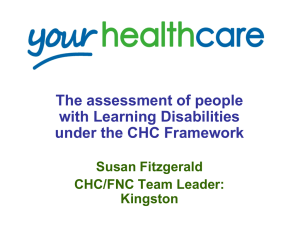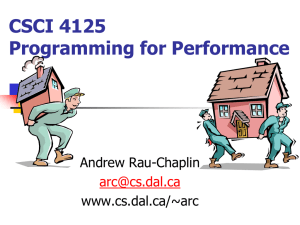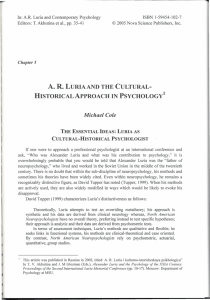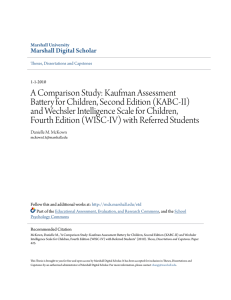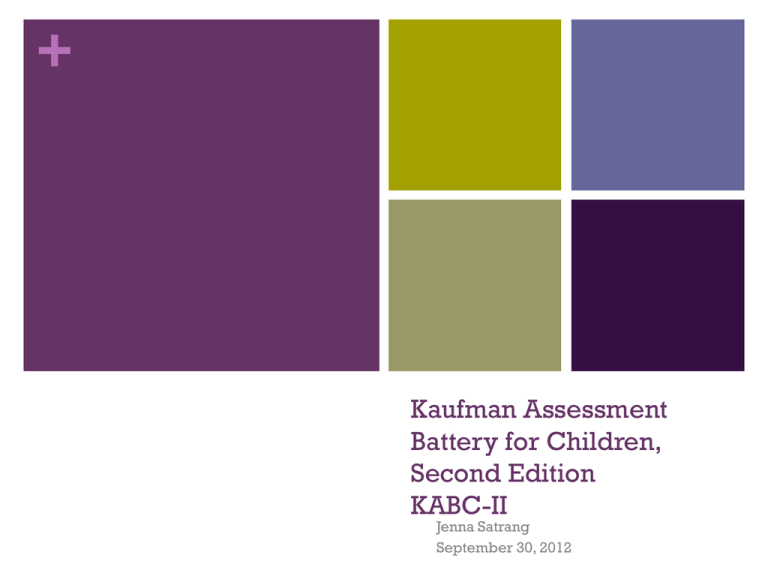
+
Kaufman Assessment
Battery for Children,
Second Edition
KABC-II
Jenna Satrang
September 30, 2012
+
Changes to KABC-II
•
Covers an extended age range: 3-18
•
Provides measurement of 5 Scales
Learning/Glr
Sequential/Gsm
Simultaneous/Gv
Planning/Gf
Knowledge/Gc
Includes a measure of verbal ability
Provides two theoretical models for interpretation (Luria & CHC)
Places new emphasis on learning ability and reasoning ability
Helps identify processing disorders for the assessment of specific
learning disabilities (SLD)
+
Dual Theoretical Model
Luria Model
Sequential Processing
Simultaneous Processing
CHC Model (Cattell-Horn-Carroll)
Short-term Memory (Gsm)
Visual Processing (Gv)
Planning Ability
Fluid Reasoning (Gf)
Learning Ability
Long-term Retrieval (Glr)
--------
Crystallized Ability (Gc)
Mental Processing Index
Fluid-Crystallized Index
(MPI)
(FCI)
+
Dual Theoretical Foundation
Name of
Luria Term
CHC Term
KABC-II Scale
Learning Ability
Long-Term Storage &
Retrieval (Glr)
Learning/Glr
Sequential Processing
Short-Term Memory (Gsm)
Sequential/Gsm
Simultaneous Processing
Visual Processing (Gv)
Simultaneous/Gv
Planning Ability
Fluid Reasoning (Gf)
Planning/Gf
Crystallized Ability (Gc)
Knowledge/Gc
Mental Processing
Index (MPI)
Fluid-Crystallized
Index (FCI)
+
Selecting the Model
Selection must be made before administering the
KABC-II and should consider reasons for referral.
The CHC model is given priority because Knowledge/Gc is
an important aspect of cognitive functioning.
The Luria model is preferred when the validity of the global
composite would be compromised by including acquired
knowledge.
Models are selected primarily with “fairness” in mind.
+
Nonverbal Index (NVI)
Story Completion
Triangles
Block Counting
Pattern Reasoning
Hand Movements
+
Not measured in KABC-II
Auditory Processing (Ga)
Processing Speed (Gs)
Reaction Time/Decision Speed (Gt)
Reading & Writing (Grw) (achievement)
Quantitative Ability (Gq) (achievement)
+
Selecting the CHC Model
The CHC model is recommended when evaluating
children with:
known or suspected disabilities in reading, written expression,
or mathematics
mental retardation
behavior disorders
attention disorders
Also recommended for determining gifted
and talented eligibility.
+
Selecting the Luria Model
The Luria model would be preferred, for example,
when testing a child:
• from a bilingual background
• whose non-mainstream cultural background may
have affected knowledge acquisition and verbal
development
• with known or suspected language disorder
• with known or suspected autism
+
Administration Times for Core Battery
Ages
MPI
FCI
Luria
Model
CHC
Model
3-4
30 Minutes
40 Minutes
5
40 Minutes
50 Minutes
6
50 Minutes
60 Minutes
7-18
55 Minutes
70 Minutes
Preparing for Administration
• Select CHC or Luria Model (or Nonverbal Index)
• Identify tests that will be administered. Depending on
AGE and MODEL selected:
• Luria Model requires 5-8 tests
• CHC Model requires 7-10 tests
• Nonverbal Index requires 4-5 tests
• Arrange testing materials.
• Supplementary tests
can be chosen later.
(except for Delayed)
Tests in 4 Easels
Easel 1:
1. Atlantis (3-18)
2. Conceptual Thinking (3-6)
3. Face Recognition (3-4)
4. Story Completion (7-18)
Easel 2:
5. Number Recall (4-18)
6. Gestalt Closure
7. Rover (6-18)
8. Atlantis Delayed
9. Expressive Vocabulary (3-6)
Core Tests in bold
Easel 3:
10. Verbal Knowledge (7-18)
11. Rebus (4-18)
12. Triangles (3-12)
Easel 4:
13. Block Counting (13-18)
14. Word Order (3-18)
15. Pattern Reasoning (5-18)
16. Hand Movements
17. Rebus Delayed
18. Riddles (3-18)
Tests 9, 10, & 18 are omitted if using Luria Model.
Tests for Nonverbal Index
Easel 1:
2. Conceptual Thinking (3-6)
3. Face Recognition (3-5)
4. Story Completion (7-18)
• 4 tests at ages 3-4
• 5 tests at all other ages
Easel 2:
None
Easel 3:
12. Triangles (3-18)
Easel 4:
13. Block Counting (13-18)
15. Pattern Reasoning (5-18)
16. Hand Movements (3-18)
+
Norm Samples
N = 3,025, ages 3:0-18:11
Conormed with KTEA-II Comprehensive Form at ages 4:6-18:11
Tested from September 2001 through January 2003
Matches March 2001 Current Population Survey (Census Bureau)
by:
Sex
Ethnicity
SES (mother’s education)
Region
SES within ethnicity
+
Validity
Validity Comparisons with ability and achievement instruments.
Global mean differences between the comparison instruments (except K-ABC and WPPSI-III) the KABC-II MPI and FCI
scores generally fell within two points of each other.
KABC,
WISC-IV,
FSIQ and MPI= .88 (adjusted correlation means across age groups)
.89 between FSIQ and FCI
.79 between FSIQ and NVI
WPPSI-III,
.73 between FISQ and MPI
.81 for the FSIQ and FCI
.81 FSIQ & NVI (younger age); .43 FSIQ & NVI (older age)
WJ III
Based on a sample of 86 students ages 7 to 16
Adjusted correlation means between global scales in the mid to high .70s
WIAT-II
Correlation between KABC-II FCI and total achievement score = .87
Studies of clinical Validity
ED, ADHD, AU, ID, LD, and those classified as Gifted.
+
Reliability
Reliabilities of the global scale indexes are extremely high.
Averaging in the mid to upper .90s for FCI and MPI
Low .90s for the NVI
Reliabilities of core and supplemental subtests across age ranges.
Mean range from .69 (Hand movements) to .92 (Rebus) for ages 3 to 6
All but three subtests (Hand Movements, Face Recognition, Gestalt Closure)
have mean coefficients of .80 or above.
Mean range from .74 (Gestalt Closure) to .93 (Rebus) for ages 7 to 18
All but four subtests (Number Recall, Hand Movements, Gestalt Closure,
Story Completion) have mean coefficients of .80
Supplemental subtests have slightly lower reliabilities on average.
Test-Retest:
Global Scales
Range from the mid .80s to the mid .90s for the FCI and MPI (lower for the
Nonverbal Scale)
Scale Level
Approximately .80 except for Gc which is in the high .80s to low .90s.
+
Personal Review
Very kid-friendly and fun
Practice- especially with triangles and Rover
Doesn’t cover all the Gs, but it is useful if you need a
nonverbal index
Intelligent Testing
“We are the most
important element in
evaluation…not the
tests.”
Alan S. Kaufman
+
References
Bain, S.K.,& Jaspers, K.E. (2010). Test Review: Review of Kaufman Brief
Intelligence Test, Second Edition.
Journal of Psychoeducational Assessment, 28(2), 167-174.
Carroll, J.B. ( 1997). The three-stratum theory of cognitive abilities. In D. P.
Flanagan, J. L. Genshaft, & P. L. Harrison (Eds.), Contemporary intellectual
assessment: Theories, tests, and issues (pp. 122-130). New York: Guilford.
Kaufman, A.S., & Kaufman, N.L. ( 2004a). Kaufman Assessment Battery for
Children, Second Edition. Bloomington, MN: Pearson, Inc
Kaufman, A.S., & Kaufman, N.L. ( 1983). Kaufman Assessment Battery for Children.
Circle Pines, MN: American Guidance Service.
Reynolds, M. R., Keith, T. Z., Fine, J., Fisher, M. E., & Low, J. A. (2007).
Confirmatory factor structure of the Kaufman Assessment Battery for
Children--Second Edition: Consistency with Cattell-Horn-Carroll theory.
School Psychology Quarterly, 22(4), 511-539.


